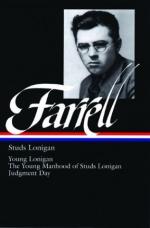|
This section contains 2,690 words (approx. 9 pages at 300 words per page) |

|
SOURCE: "James T. Farrell: Two Twilight Images," in Fifty Years of the American Novel: A Christian Appraisal, Charles Scribner's Sons, 1952, pp. 237-56.
In the excerpt below, O'Malley argues that Farrell's fictional world is unremittingly bleak and spiritually degenerate, the result of a decayed civilization and an impoverished Catholicism.
The fiction of Farrell is likely to bring immediately to mind a well-known figure imagined by the literary historian Taine: in this figure men are seen as field-mice being trampled to death by elephant herds, which portray the brutal forces of nature and civilization. Surely the people who stir about in Farrell's books seem as weak and small and helpless as field-mice, crushed in fear, blinded by poverty and debased by their own wild, unbridled instincts (instincts vaster than will or mind or soul, it would appear) and by the impact of a dark, dangerous, industrial and commercial civilization. In...
|
This section contains 2,690 words (approx. 9 pages at 300 words per page) |

|


